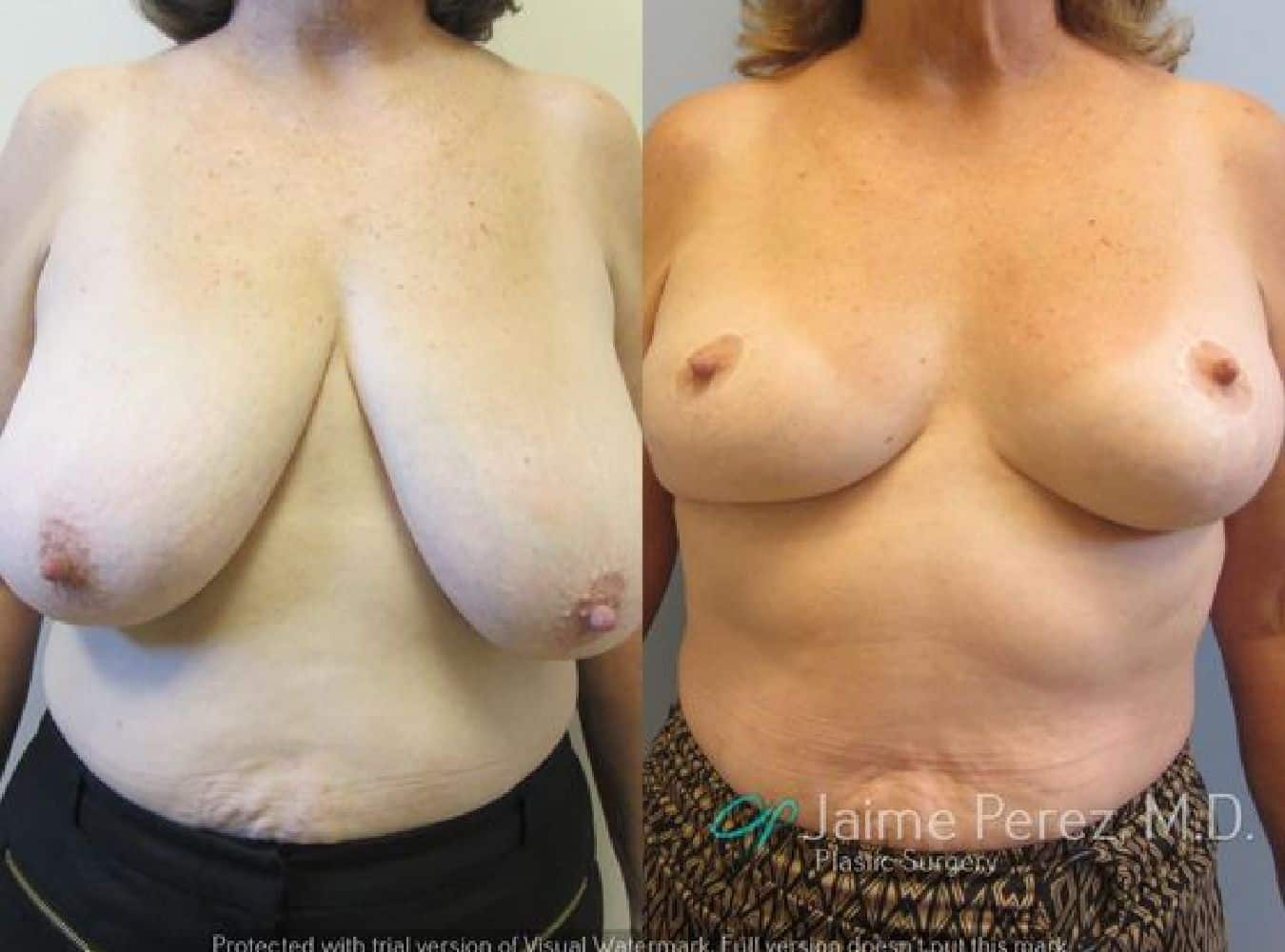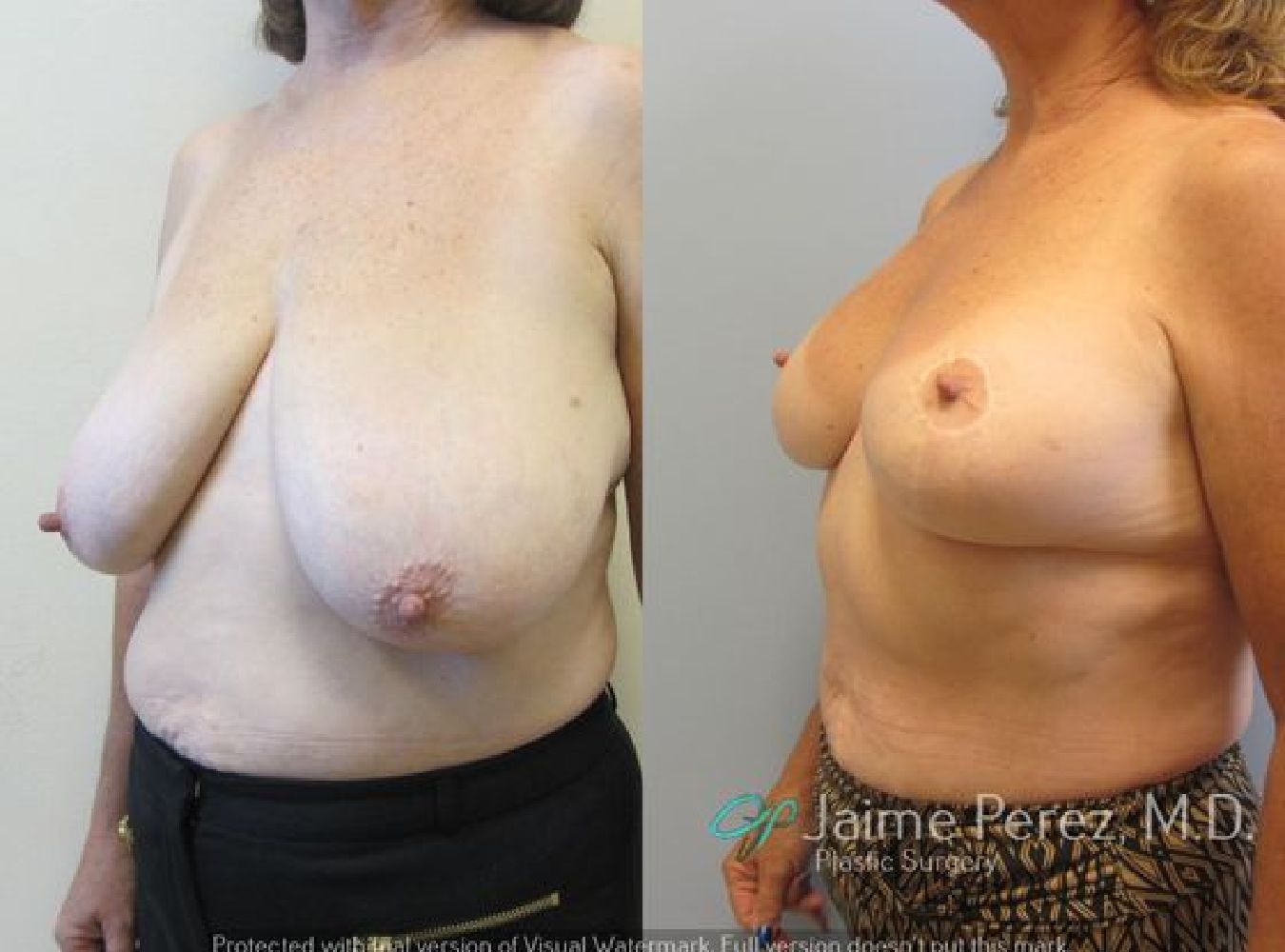Breast Reduction in Tampa, FL
Contact Model
Model
Breast Reduction
Is the size of your breasts limiting your ability to run, play sports, or exercise? Do you feel uncomfortable with the size of your breasts and alter your clothes accordingly? Do you suffer from upper back, neck, or shoulder pain?
If you are currently considering breast reduction surgery, you probably answered yes to at least two or three of these questions. For many women, having large breasts is an aggravation and stress they’ve been dealing with for years. If you are one of these women, Dr. Jaime Perez and his compassionate and understanding staff are available to help you take control of your future, and your body. His minimally invasive and short scar techniques, meticulous attention to detail, and gentle touch will have you back in the gym or beach in no time!
Macromastia or hypermastia (a.k.a. large breasts) occurs during puberty or with advanced age and is usually secondary to genetic predisposition rather than an abnormality with circulating hormones. Large breasts are generally compromised of larger than usual amounts of fatty and fibrous tissue rather than glandular breast tissue. Because of the excess weight, larger breasts often have a sagging, flat appearance rather than a more perky, round shape seen with smaller breasts.
With increasing size, women with large breasts often experience several psychological and physical symptoms. Embarrassment and difficulty finding clothes that fit as well as upper back/neck pain and shoulder grooving from bra straps are among the most common. In private practice since 2000, Dr. Perez and his staff are familiar with the concerns women seeking breast reduction have. His patient and understanding manner will make you feel comfortable talking to him about your complaints and goals for surgery.
Breast reduction surgery is designed to reduce breast volume and alleviate the unwanted emotional and physical side effects of having excessively large breasts. Years ago, surgeons considered breast reduction more of a “breast amputation surgery” with little attention paid to the final cosmetic result or breast shape. In addition to reducing breast size, today’s breast reduction specialists like Dr. Jaime Perez also focus on reshaping the breast into a more youthful, conical shape while repositioning the nipple to a higher, more attractive level.
We Offer Virtual Consultations for Your Convenience
Dr. Perez is proud to offer virtual consultations so you can discuss your cosmetic goals and learn about treatment options from the comfort of your home.
 Actual Patient
Actual Patient
Breast Reduction
Ideal Candidate
The ideal candidate for a breast reduction is a woman who is unhappy with the size of her breasts, is having physical and mental side effects directly associated with the weight and volume of her breasts, and is aware that she must trade scars on her breasts for smaller, shapelier breasts. Additionally, women considering any kind of breast surgery should be non-smokers or at least smoke-free for three months before and after surgery.

Interested in Breast Reduction in Tampa, FL?
We’d love to assist you on this exciting journey! Schedule a consultation with Dr. Perez today to discuss your goals. You can use our online contact form or call us at (813) 877-3739.
We look forward to hearing from you.
Surgical Technique
A breast reduction is usually performed under general anesthesia on an outpatient basis, meaning the patient goes home the same day. Rarely, if a patient has other procedures performed in addition to a breast reduction, an overnight stay may be required. The surgery usually takes three to four hours to perform but varies depending on the individual technique the patient and Dr. Perez decides upon.
Liposuction or Scarless Breast Reduction – Liposuction or scarless breast reduction is ideal for younger patients with tight, elastic skin, good breast shape, no familial history of breast cancer, and those who desire a small reduction (i.e. less than 500-cc per breast). Additionally, older patients with heavy breasts who wish to avoid an invasive surgery and have less concern over an ideal, cosmetic result may also consider liposuction or scarless breast reduction. While not actually scarless, tiny incisions are made on the medial and lateral aspect of the base of the breast to allow for the introduction of a liposuction cannula. Traditional or ultrasound-assisted liposuction (click here to learn about Liposuction) is then performed to reduce the breast to the desired size. The obvious advantages to this surgery are that larger scars are avoided and the blood supply to the nipple-areolar complex is not compromised by a more invasive surgery. The disadvantage to liposuction or scarless breast reduction is that the overall shape and nipple position of the breast is not altered. Thus, patients with drooping, or ptosis, of the breast are not a good candidate for this operation. Another disadvantage is that the breast tissue removed via liposuction cannot be adequately examined by a pathologist.
Short Scar or Minimally Invasive Breast Reduction – A short scar or minimally invasive breast reduction uses a combination of incisions and liposuction to reduce breast volume and alter breast shape to a moderate degree. Ideal patients for this procedure have relatively good quality skin, a small degree of breast sagging, and desire a moderate reduction (i.e. greater than 500-cc) in breast volume. Incisions are placed either around the nipple-areola complex alone or may also include a vertical incision extending from the bottom of the nipple to the inframammary fold (i.e. where the bottom of the breast crease touches the chest wall). These incisions allow the surgeon access to the breast tissue in order to perform a breast lift (click here to learn about Breast Lift) along with a breast reduction when appropriate. Liposuction is then utilized to further reduce the breast to the desired size. The benefit to this procedure is a lessened scar burden when compared to traditional breast reduction surgery. Similar to liposuction or scarless breast reduction, the breast tissue removed via liposuction cannot be adequately examined by a pathologist. Therefore, patients with a family or personal history of breast cancer are not candidates for this surgery.
Traditional Breast Reduction – Traditional breast reduction uses a combination of internal breast tissue incisions and external skin incisions to reduce breast volume and restore breast shape. Ideal patients for this surgery require a large reduction (i.e. greater than 750-cc to 1000-cc per breast) and dramatic reshaping of the breast mound. These patients often have sagging, pendulous breasts with inferiorly displaced nipples. Incisions are placed around the nipple-areolar complex, down from the bottom of the nipple extending to the inframammary fold (i.e. lollipop or vertical breast reduction), and may incorporate a horizontal incision hidden within the inframammary fold (i.e. anchor or inverted-T breast reduction). The advantage of this technique is that large amounts of breast tissue can be removed and dramatic reshaping and elevation of the nipple can be performed through the more aggressive incisions. The obvious disadvantages, however, is the greater number of scars on the breast and possibility for wound healing problems, scar widening, or postoperative elevation of the nipple or flattening of the breast (particularly with the anchor or inverted-T technique).
Free Nipple Grafting Breast Reduction – A free nipple grafting breast reduction involves the actual removal of the nipple from the underlying breast tissue and reattachment at the end of the surgery in the correct position as a skin graft. Candidates for this surgery have extremely large breasts and long distances between their breastbone and nipple (i.e. greater than 30 to 40-cm) and between the nipple and inframammary fold (i.e. greater than 18-cm). Additionally, patients with medical conditions requiring short anesthesia times or systemic diseases that impair blood flow may require this procedure rather than a traditional breast reduction. Incisions are like those of the anchor or inverted-T breast reduction and allow for large volumes of breast tissue to be removed and reshaped. The advantage to this operation is the limited anesthesia time and decreased chance of total nipple-areolar complex loss or necrosis. Because the nipple is detached from the body and replaced as a skin graft, the disadvantages are pronounced and include permanent loss of nipple sensation, loss of ability to breast-feed, and possible changes in nipple color in patients with dark skin.
Considerations
Breast reduction surgery enjoys the highest patient satisfaction rate in all of plastic surgery. Up to 97% of breast reduction patients report improvement in preoperative symptoms and over 90% of patients report being extremely satisfied with their outcomes.
Despite this extraordinarily high patient satisfaction rate, breast reduction surgery does carry its own set of risks and known complications. The most common untoward effect of beast reduction surgery is altered nipple sensation postoperatively. Up to 25% of patients report decreased sensation, changes in sensation, and occasionally increased sensation. Wound healing problems, particularly with the anchor or inverted-T breast reduction pattern are encountered in up to 20% of patients. Thankfully, almost all wounds following a breast reduction can be treated in the clinic and rarely require a return trip to the operating room. Partial or complete loss of the nipple-areolar complex occurs in 4-7% of patients undergoing breast reduction and is more common in smokers and those with a very large preoperative breast volume or length. Unsightly scarring occurs in up to 4% of patients and is more common in patients with dark skin, smokers, and those undergoing the anchor or inverted-T breast reduction technique.
The ability to breast-feed is a common concern amongst women considering a breast reduction. While studies differ in their findings, it is generally accepted that most (at least 75%) if not nearly all women will have the ability to breast feed following a breast reduction, but the majority of women may need to supplement feedings with formula. The exception, however, is that women who have undergone a free nipple grafting breast reduction will be unable to breast feed as the connection between their nipple and milk ducts has been severed. Fortunately, women electing for a free nipple grafting breast reduction are usually past childbearing age and are not concerned about their inability to breast-feed.
Additional considerations following a breast reduction include the possibility of postoperative breast asymmetry, bleeding, infection, insufficient reduction, over-reduction, and change in breast shape over time. Dr. Perez examines all of his patients within one to two days after surgery so that in the rare chance there is a complication, it can be diagnosed and addressed appropriately.
Postoperative Care
Breast reduction surgery typically lasts three to four hours and is performed on an outpatient basis under general anesthesia. Rarely, surgical drains are placed during the procedure and are removed within the first week after surgery. At the first postoperative appointment, the sterile surgical dressings are removed and replaced with a supportive surgical bra. Patients are expected to wear this bra at all times for three weeks. While every patient is different, most women are able to return to work in one week, light exercise in three weeks, and resume strenuous activity (including overhead lifting, etc…) after five weeks. Antibiotics and pain medicine are prescribed following the surgery.
Patient Testimonials
Thank you so much for the amazing job you have done!! I am so happy with my results! You truly have been given the special gift and use that to make people feel beautiful, physically and mentally!! Again thank you so much!!
Amanda
Thank you for taking such good care of me. I have been to many plastic surgeons in the past and I know you guys are the best! God works in mysterious ways and I was blessed to find you. I truly don’t believe anyone else could have done this. THANK YOU!
Brandi
I was very impressed and satisfied with my procedure and how well I was treated. The entire staff always has a smile on their face and a kind word. Dr. Jaime Perez has a bedside manner that evokes confidence and appreciation in his abilities
Milan

Start Your Transformation Today
Tampa Office
307 S MacDill Ave.
Tampa, FL 33609

